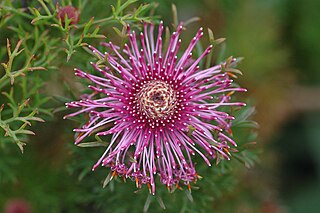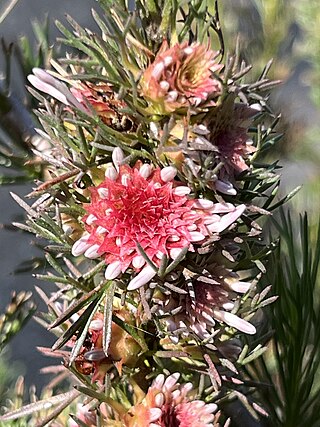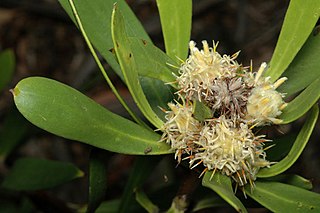
Isopogon, commonly known as conesticks, conebushes or coneflowers, is a genus of about forty species of flowering plants in the family Proteaceae, and are endemic to Australia. They are shrubs with rigid leaves, bisexual flowers in a dense spike or "cone" and the fruit is a small, hairy nut.

Isopogon formosus, commonly known as rose coneflower, is a species of flowering plant in the family Proteaceae and is endemic to the south-west of Western Australia. It is a shrub with divided leaves with cylindrical segments, and spherical to oval heads of pink or red flowers.

Isopogon cuneatus, commonly known as coneflower, is a species of plant in the family Proteaceae and is endemic to the south-west of Western Australia. It is a shrub with oblong to egg-shaped leaves with the narrower end towards the base, and flattened-spherical heads of glabrous pale to purplish pink flowers.

Isopogon dubius, commonly known as pincushion coneflower, is a species of plant in the family Proteaceae and is endemic to the south-west of Western Australia. It is a shrub with sharply-pointed, deeply lobed or pinnate leaves and more or less spherical heads of pink to reddish pink flowers.

Isopogon adenanthoides, commonly known as the spider coneflower, is species of flowering plant in the family Proteaceae and is endemic to the southwest of Western Australia. It is an erect shrub with sharply-pointed, trifid leaves and spherical heads of pink flowers.

Isopogon trilobus, commonly known as barrel coneflower, is a species of flowering plant in the family Proteaceae and is endemic to South Coast Western Australia. It is a shrub with wedge-shaped leaves with lobed or toothed leaves, and oval, spherical or barrel-shaped heads of cream-coloured to yellow flowers.

Isopogon asper is a species of plant in the family Proteaceae and is endemic to the south-west of Western Australia. It is a low shrub with crowded pinnate leaves and flattened spherical heads of glabrous pink flowers.

Isopogon alcicornis, commonly known as the elkhorn coneflower, is a plant in the family Proteaceae and is endemic to part of the South Coast Western Australia. It is a low shrub with pinnately-lobed leaves and oval heads of hairy, white or pink flowers.

Isopogon attenuatus is a species of plant in the family Proteaceae and is endemic to the south-west of Western Australia. It is a shrub with oblong to spatula-shaped or linear leaves and spherical heads of yellow flowers.

Isopogon baxteri, commonly known as the Stirling Range coneflower, is a species of plant in the family Proteaceae and is endemic to the south-west of Western Australia. It is an erect shrub with wedge-shaped, often 3-lobed, toothed leaves and flattened spherical heads of hairy pink flowers.

Isopogon divergens, commonly known as spreading coneflower, is a species of plant in the family Proteaceae and is endemic to the south-west of Western Australia. It is a shrub with pinnate leaves and more or less spherical heads of glabrous pink flowers followed by an oval to cylindrical fruiting cone.

Isopogon teretifolius, commonly known as nodding coneflower, is a species of flowering plant in the family Proteaceae and is endemic to the southwest of Western Australia. It is an erect shrub with cylindrical, sometimes branched leaves, and flattened-spherical heads of hairy pinkish flowers.

Isopogon polycephalus, commonly known as clustered coneflower, is a species of plant in the family Proteaceae and is endemic to the South coast of Western Australia. It is a spreading shrub with linear to lance-shaped leaves with the narrower end towards the base, and clusters of more or less spherical heads of white, cream-coloured or yellow flowers.

Petrophile megalostegia is a species of flowering plant in the family Proteaceae and is endemic to southwestern Western Australia. It is a shrub with needle-shaped or flattened, sometimes S-shaped leaves with a sharply-pointed tip, and more or less cylindrical heads of silky-hairy, yellow to cream-coloured flowers.

Petrophile plumosa is a species of flowering plant in the family Proteaceae and is endemic to southwestern Western Australia. It is a shrub with rigid, sharply-pointed, sometimes lobed leaves, and more or less spherical heads of hairy, pale yellow flowers.

Isopogon crithmifolius is a species of plant in the family Proteaceae and is endemic to the south-west of Western Australia. It is a shrub with divided leaves and more or less spherical heads of glabrous reddish pink flowers.

Isopogon scabriusculus is a species of flowering plant in the family Proteaceae and is endemic to southwestern Western Australia. It is a shrub with cylindrical, or narrow flat, sometimes forked leaves, and spherical to oval heads of pink or red flowers.

Isopogon heterophyllus is a plant in the family Proteaceae and is endemic to the southwest of Western Australia. It is a shrub with simple or pinnate, cylindrical leaves and hairy, usually pink flowers.

Isopogon inconspicuus is a plant in the family Proteaceae and is endemic to the southwest of Western Australia. It is a small shrub with pinnate leaves with cylindrical leaflets, and pink to purple flowers covered with grey hairs.
Petrophile multisecta, commonly known as Kangaroo Island conesticks, is a species of flowering plant in the family Proteaceae and is endemic to Kangaroo Island in South Australia. It is a prickly shrub with rigid, much-divided leaves with sharply pointed tips, oval to spherical heads of hairy cream-coloured flowers and oval fruit.


















